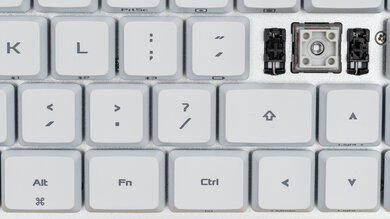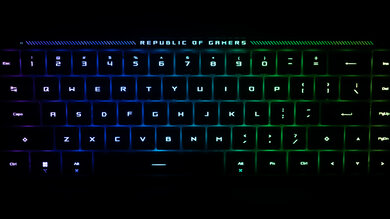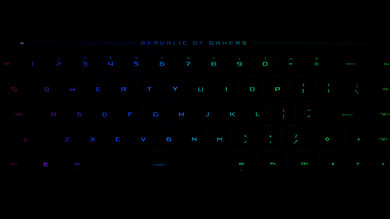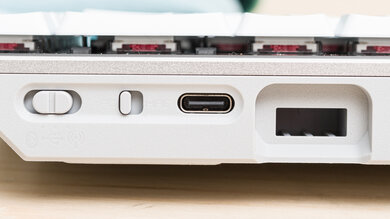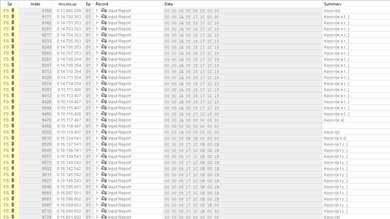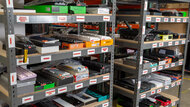The ASUS ROG Falchion RX Low Profile is a wireless mechanical keyboard that continues the ASUS Falchion lineup of compact gaming keyboards. This keyboard connects wirelessly with an included 2.4 GHz receiver or via Bluetooth. It has a touch panel for media controls and a physical toggle for switching between Windows and macOS compatibility modes.
It uses pre-lubed, low-profile RX ROG Optical switches—available in either linear or clicky varieties—and RGB backlighting that you can customize, among other settings, in the configuration software. It also comes with a plastic dust cover designed to sit over the front of the keyboard when not in use or for transit. While using the keyboard, you can move this plastic cover onto the back of the keyboard, and it has a set of large rubber feet to help prevent the keyboard from sliding around on desks.
Note: We experienced occasional key chatter (repeated keystrokes) while testing this keyboard. We've seen a small number of reports from the wider community experiencing this issue, but it's currently unclear how widespread it is and whether it's something you're likely to experience. We're closely monitoring the situation and will update our review as needed. For more details about this issue, see the Build Quality section below.
Our Verdict
The ASUS ROG Falchion RX Low Profile is an excellent gaming keyboard. It has good overall build quality and outstanding latency performance, making it well-suited for casual or competitive gaming. It also has full RGB backlighting that you can customize along with a range of other settings using the configuration software, and its low-profile design is comfortable to use without a wrist rest. Unfortunately, we experienced key chatter on the unit we tested, which can significantly impact the gaming experience. For more details, see the Build Quality section.
-
Excellent latency performance.
-
Slim, low-profile design is comfortable to use without a wrist rest.
-
Programmable RGB backlighting and shine-through keycaps.
-
Occasional key chatter (repeated keystrokes).
-
Only available in a white colorway; may not be a visual match for all setups.
The ASUS ROG Falchion RX Low Profile is good for office work despite not being specifically designed for this use. It has good overall build quality and is comfortable to type on without a wrist rest due to its low profile design. This keyboard's linear switch option is also extremely quiet to type on and very unlikely to those around you, even in noise-sensitive environments. Unfortunately, we experienced key chatter on the unit we tested, which significantly impacted this keyboard's typing quality. For more details, see the Build Quality section.
-
Bluetooth connectivity and multi-device pairing with up to three devices.
-
Slim, low-profile design is comfortable to use without a wrist rest.
-
Occasional key chatter (repeated keystrokes).
-
Only available in a white colorway; may not be a visual match for all setups.
The ASUS ROG Falchion RX Low Profile is great for mobile devices and tablets. It has good overall build quality and supports multi-device pairing via Bluetooth with up to three devices simultaneously. Its compact, low-profile design makes it easy to carry around and transport, and this board comes with a plastic dust cover. However, this cover doesn't snap in place or provide the same protection as a more conventional carrying case. Unfortunately, we also experienced key chatter on the unit we tested, significantly impacting typing quality. For more details, see the Build Quality section.
-
Bluetooth connectivity and multi-device pairing with up to three devices.
-
Occasional key chatter (repeated keystrokes).
The ASUS ROG Falchion RX Low Profile is good for programming. Overall, it has good build quality, and its slim design makes it comfortable to type on without a wrist rest. It has customizable RGB lighting and shine-through keycaps that make legends clearly visible in darker rooms, and you can program macros to any key. It's missing a function row and navigation cluster, so you may need to rely more heavily on shortcuts or rebinds, depending on your workflow. Unfortunately, we also experienced key chatter on the unit we tested. For more details, see the Build Quality section.
-
Slim, low-profile design is comfortable to use without a wrist rest.
-
Programmable RGB backlighting and shine-through keycaps.
-
Occasional key chatter (repeated keystrokes).
-
Only available in a white colorway; may not be a visual match for all setups.
The ASUS ROG Falchion RX Low Profile is decent for use in an entertainment or home theater setup. It has good overall build quality and connects wirelessly with a 2.4 GHz receiver or via Bluetooth, with multi-device support for up to three devices. It also has dedicated media controls and full RGB backlighting with shine-through keycaps, making legends easy to read in darker rooms. Unfortunately, we also experienced key chatter on the unit we tested, significantly impacting typing quality. For more details, see the Build Quality section.
-
Bluetooth connectivity and multi-device pairing with up to three devices.
-
Programmable RGB backlighting and shine-through keycaps.
-
Touch panel for media controls.
-
Occasional key chatter (repeated keystrokes).
The ASUS ROG Falchion RX Low Profile provides excellent raw performance with very low single-key and multi-key latency. It also takes full advantage of its 1000Hz polling rate without getting bottlenecked by other latency components, making it well-suited for playing games in any genre and at any competitive level.
-
Excellent latency performance.
- 8.6 Gaming
- 7.6 Office
- 8.4 Mobile/Tablet
- 7.6 Programming
- 7.2 Entertainment / HTPC
- 8.9 Raw Performance
Changelog
- Updated May 31, 2024: Review published.
- Updated May 27, 2024: Early access published.
- Updated May 21, 2024: Our testers have started testing this product.
- Updated May 13, 2024: The product has arrived in our lab, and our testers will start evaluating it soon.
- Updated May 07, 2024: We've purchased the product and are waiting for it to arrive in our lab.
Check Price
Differences Between Sizes And Variants
The ASUS ROG Falchion RX Low Profile is available with linear ROG RX Low-Profile Optical Red or clicky ROG RX Low-Profile Optical Blue switches. At the time of writing, it's only available in a white color option. We bought and tested the linear Red switch option.
You can see the label of our unit here.
Compared To Other Keyboards
The ASUS ROG Falchion RX Low Profile fills a specific niche as there aren't very many dedicated low-profile gaming options in the current market. Most low-profile gaming options that do exist are full-size models, like the Corsair K100 AIR, the Razer DeathStalker V2 Pro, and the Logitech G915 LIGHTSPEED. The Falchion RX Low Profile offers a compact (65%) alternative. Its smaller form factor not only means it takes up considerably less space in a desktop setup and leaves you more room for mouse movements but also makes it a much more portable option that's great for tournament players or anyone who frequently travels with their keyboard in tow. Also, this keyboard has a customizable touch bar with a small display. It keeps the face of the keyboard free of clutter and still provides dedicated media controls and backlighting brightness controls by default.
Unfortunately, we experienced some key chatter (repeated keystrokes) on the unit we bought and tested, so if you're interested in this board, we recommend purchasing either directly from ASUS or an authorized vendor with warranty support so you can RMA your keyboard if need be. This keyboard is also only available in a white colorway at the time of writing, which may not suit everyone's taste or desktop setup.
For more recommendations, see our picks for the best keyboards, the best wireless keyboards, and the best low-profile keyboards.
Both the ASUS ROG Falchion RX Low Profile and the ASUS ROG Azoth are compact, wireless gaming keyboards with roughly equivalent gaming performance. The Falchion has a slightly smaller 65% layout and a much slimmer low-profile design. It also has a touch bar. On the other hand, the Azoth has a larger 75% form factor, which includes dedicated arrow keys and a full function row. It has a customizable OLED screen and generally a more customizable design with a hot-swappable PCB and much more acoustic material inside the case, providing a more premium-feeling typing experience.
The Logitech G515 LIGHTSPEED TKL and the ASUS ROG Falchion RX Low Profile are wireless, low-profile gaming keyboards. The Logitech has a slightly larger TKL form factor, higher-quality PBT keycaps, and somewhat better build quality overall. Comparatively, the ASUS has a slightly smaller compact (60%) design. It also offers slightly better overall raw performance, supports Bluetooth multi-device pairing, and comes with a dust cover that you can store as a backplate. Unfortunately, we experienced occasional key chatter on our unit. However, it's worth noting that we haven't encountered many other reports online of this issue, suggesting it may not be very widespread.
Both the Razer DeathStalker V2 Pro and the ASUS ROG Falchion RX Low Profile are wireless gaming keyboards with low-profile designs and roughly the same gaming performance. The standout difference between them is size: the Razer is a much larger full-size model, while the ASUS is a compact (65%) model. Otherwise, the Razer has physical button media controls, including a scroll bar. Comparatively, the ASUS has a customizable touch bar.
The ASUS ROG Falchion RX Low Profile and the Logitech G915 LIGHTSPEED are wireless low-profile gaming keyboards with comparable raw performance. The biggest difference between them is their size. The ASUS is a much smaller compact (65%) model. It also supports Bluetooth and has a customizable touchpad to control things like backlighting and media controls. The Logitech, on the other hand, is a much larger full-size model. It has a set of physical button media controls and a scroll bar, as well as five dedicated macro buttons, which the Falchion lacks.
The ASUS ROG Falchion RX Low Profile and the Corsair K100 AIR are wireless, low-profile gaming keyboards. The ASUS has a much smaller compact (65%) form factor and has a touch bar that you can customize using the configuration software. The Corsair is a significantly larger full-size model, but it's also noticeably thinner. It offers slightly better overall gaming performance and supports a higher maximum polling rate. It also has a digital screen display, dedicated macro keys, and dedicated physical buttons for media controls.
The ASUS ROG Falchion RX Low Profile and the SteelSeries Apex Pro Mini Wireless are both compact wireless gaming keyboards with similar raw gaming performance. THE ASUS is a slightly larger 65% model with a slimmer low-profile design and a customizable touch bar. Comparatively, the SteelSeries is a bit smaller, with a 60% form factor, but the standout difference is that it uses analog switches, which allow you to customize the pre-travel and reset distance of individual switches.
Test Results
The ASUS ROG Falchion RX Low Profile has a compact (65%) form factor, which means it has dedicated arrow keys and most keys from the navigation cluster, but it's missing the function row and Numpad found on full-size keyboards.
The above measurements are with the plastic dust cover removed. We've also taken supplemental measurements with the plastic cover placed under the keyboard below.
- Height: 2.9 cm
- Width: 31.2 cm
- Depth: 11.6 cm
- Weight: 0.715kg
The ASUS ROG Falchion RX Low Profile has decent overall build quality. However, we encountered occasional key chatter (repeated keystrokes) during testing. This issue significantly impacts this keyboard's typing quality and gaming experience as unintentional repeat inputs occur on multiple keys and with unpredictable frequency. This issue is particularly unusual because the manufacturer advertises its switches as optical, which typically aren't prone to chattering. However, there's some language on ASUS's product page for these switches suggesting they may be a hybrid optical-mechanical design. This suggests it may not be an issue with the switches but rather a firmware issue that ASUS can address in a future update. We've only seen limited reports from the community about this issue, so it may only be a problem with a small number of units. We will continue monitoring the situation and update our review as needed. If you have this keyboard and have encountered key chatter issues, reach out to us in the comments.
Apart from the chatter issue we encountered on the unit we bought and tested, other build-quality elements of this keyboard are impressive. It has minimal deck flex, with a plastic bottom chassis and an aluminum top plate. Its ROG RX Low-Profile switches are pre-lubed from the factory and feel smooth overall. The keycaps are also very stable, and while they're made of ABS plastic (which often develops a slippery, shiny finish with extended use), ASUS indicates they have a UV coating designed to mitigate this. Unfortunately, while the stabilizers also do a great job of keeping larger keys stable, they aren't pre-lubed from the factory, so they sound somewhat inconsistent and produce faint rattling sounds. You can see a video of stabilizer performance here. That said, there are also two layers of silicone dampening foam inside the case that help to even out the overall sound profile and keep pinging noise to a minimum.
On the back of the board, there are a set of flat rubber feet and two rubber capped flip-out feet that all do a great job of keeping the board firmly in place on your desk without sliding around.
There's a mirrored finish panel on the top of the keyboard with Republic of Gamers branding and a touch control panel with dedicated media controls. However, this mirrored finish shows fingerprints easily and may be prone to scratches with rougher use.
Lastly, this keyboard also includes a plastic cover that you can place over the front or back. ASUS describes this as a dust cover. Unfortunately, it doesn't clip into place and is somewhat flexible in the middle, so it doesn't provide the same degree of protection a hard shell carrying case would. You can see images of the dust cover on top of the keyboard here and here.
This keyboard has a low-profile design, making it fairly comfortable to use with your palms resting on your desk without a wrist rest.
There are flip-out feet on the back of the keyboard that provide two additional incline angles. The Home Row Height listed above is in the tallest configuration, with the feet extended.
The Home Row Height at a medium incline is 24.4 mm, and with the board lying flat with the flip-out feet fully closed, the Home Row Height is 21.3 mm.
This keyboard doesn't provide hardware customizability options.
The ASUS ROG Falchion RX Low Profile has full RGB backlighting. The touch panel on the top left edge allows you to adjust brightness, and you can cycle through RGB effects using hotkey combinations or the configuration software.
This keyboard comes with a braided USB-A to USB-C charging cable. It retains some kinks from its packaging.
ASUS advertises that this keyboard has a battery life of up to 430 hours when connected with its 2.4 GHz receiver and with all backlighting off.
You can record macros on the ASUS ROG Falchion RX Low Profile using hotkey combinations or with the configuration software.
This keyboard has a touch panel on the top left edge that, by default, provides dedicated media controls and allows you to adjust backlighting brightness. You can see an animation from ASUS's product page for this keyboard that demonstrates how this feature works.
The touch controls allow you to cycle between control modes with a button next to the touch panel and customize how the panel functions using the configuration software. During testing, we found that this panel works well but occasionally fails to register inputs.
This keyboard has a Caps Lock indicator light but supports other lock keys using hotkey combinations, including FN lock, Scroll Lock, and Windows lock, which provide on-screen notifications but don't have indicator lights.
A range of other hotkey combinations are supported, including battery life display, windows lock, RGB effect presets, etc. Many hotkeys are indicated with printed legends on the front edge of keycaps. To reference a full list of hotkeys, you can see a digital version of the user manual from ASUS's website here.
Altogether, this keyboard provides only satisfactory typing quality. While most aspects are impressive, we experienced occasional key chatter (repeated keystrokes) on the unit we bought and tested, which significantly reduced the quality of the typing experience. For more details, see the Build Quality section.
The key chatter issue aside, the switches are pre-lubed from the factory and feel quite smooth. Two layers of internal sound-dampening silicone foam help round out the sound profile and minimize the overall typing noise.
All keys are very stable, and keystrokes are very consistent, even if you hit a key on an edge or corner. The stabilizers also do a great job of making keystrokes on larger keys feel even and consistent. Unfortunately, the stabilizers aren't pre-lubed. They feel somewhat inconsistent, and they rattle slightly but noticeably while typing.
The ASUS ROG Falchion RX Low Profile is very quiet with the ROG RX Low-Profile Optical Red switches and is very unlikely to bother those around you.
You can also buy this keyboard with ROG clicky RX Low-Profile Optical Blue switches, which we expect to be significantly louder with high-pitched clicks.
You can buy this keyboard with linear ROG RX Low-Profile Optical Red switches or clicky ROG RX Low-Profile Optical Blue switches, both of which are pre-lubed from the factory.
We bought and tested this keyboard with linear ROG RX Low-Profile Optical Red switches, which are smooth and lightweight. Their low-profile design also has very short pre-travel, making keystrokes feel extremely quick and responsive.
You can also buy this keyboard with clicky ROG RX Low-Profile Optical Blue switches, which are heavier-feeling and have a slightly longer pre-travel distance. They also have a small but noticeable tactile bump to overcome and produce an audible click on each downstroke.
Unfortunately, we encountered occasional key chatter (repeat keystrokes) during testing. You can read more about this issue in the Build Quality section and can see what this looks like on our measuring equipment here.
The ASUS ROG Falchion RX Low Profile has remarkably low single-key latency performance. It delivers an extremely responsive gaming experience at any competitive level.
The ASUS ROG Falchion RX Low Profile has amazing multi-key latency performance, making it well-suited for playing any game that requires additional inputs while you're already pressing and maintaining multiple keys.
This keyboard has an excellent 4-chord and 8-chord split delay, making it a great choice for playing rhythm games or other games requiring many simultaneous inputs.
The ASUS ROG Falchion RX Low Profile uses Armoury Crate for customization. This software is reasonably straightforward and allows you to customize various expected settings, including key assignments, macros, power settings, and RGB lighting.
That said, as with software options from other major manufacturers, Armoury Crate is the source of widespread criticism from the broader community. While we didn't experience any issues during the testing of this keyboard, many users online criticize this software for being unnecessarily bloated, requiring frequent updates, and taking up disproportionate system resources, among other complaints. This software may be frustrating if you prefer more lightweight software options or no software at all.
The configuration software is available on Windows and MacOS systems using an M1 chip or later. On Linux systems, all default keys work as expected, but there isn't a compatible software version.
All default controls, including media controls, work on Android, iOS, and iPadOS devices. However, there isn't a compatible configuration software version for these devices.
Comments
ASUS ROG Falchion RX Low Profile: Main Discussion
Let us know why you want us to review the product here, or encourage others to vote for this product.
- 32120
I got one of these from Amazon - blue 2-3 months ago. As someone who has more than 10 mechanical keyboards, i do have my pet peeve (deal breakers) with respect to what MKs I put into use but tbh this one is my go to for most things. I think a major reason is the battery life has been above and beyond what I expect.
Below one asked about the “horible clidking” (of the switches/keypress). Well, the click sounds kinda hollow and dry. It hasn’t ever bothered me, but i do like a bit of clickity clackity in my life. Perfect backlighting, layout works for me on every OS I need (win, Mac, Lin, iOS).
- 21010
Backlight Features : You show a black display, is this a white keyboard that can be adjusted to become black through its backlighting or is that a different variety of purchasable option. I want the black but I keep seeing white everything, could they be one and the same?
Hi Matriaz,
This keyboard is only available in a white color at the time of writing.
The other photos in the Backight Features section where the keyboard appears black because those photos are taken with the overhead lighting in the testing room turned off, so you can see what the keyboard looks like in the dark.
I hope that answers your question. Thanks for reaching out!
- 21010
Backlight Features :
You show a black display, is this a white keyboard that can be adjusted to become black through its backlighting or is that a different variety of purchasable option. I want the black but I keep seeing white everything, could they be one and the same?
This product has been merged with ASUS ROG Falchion RX Low Profile 65% Wireless Gami. Follow the discussion here.





